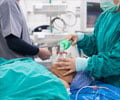A technique for automatically controlling anaesthesia during surgical operations has been created by researchers.
The new system detects the hypnotic state of the patient at all times and supplies the most appropriate dose of anaesthetic."This is an efficient control technique which regulates anaesthesia in operating theatres by computer, with the aim of adapting the dose of the drug administered according to the individual characteristics of each patient", Juan Albino Méndez, lead author of the study and a researcher in the Anaesthesia Control Group at the University of La Laguna (ULL), tells SINC.
With the team of anaesthetists from the University Hospital of the Canary Islands, the group has developed an IT tool together.
The new system, which has been published in Computer Methods in Biomechanics and Biomedical Engineering, keeps the patient in the desired hypnotic state throughout the operation.
The system uses sensors and a monitor to record the patient's encephalogram (EEG) and bispectral index (BIS), a parameter without units that measures hypnotic state and relates this to the patient's level of consciousness.
The BIS value fluctuates between 100 (maximum possible state of alertness) and 0 (lack of cortical electrical activity, the state of deepest unconsciousness). This research focuses on the BIS region involved in general anaesthesia, between 40 and 60.
Advertisement
In order to validate the technique, the researchers successfully carried out simulations using various models they developed themselves, and also tested it on 15 volunteer patients, aged between 30 and 60, at the University Hospital of the Canary Islands.
Advertisement
Source-ANI
RAS











